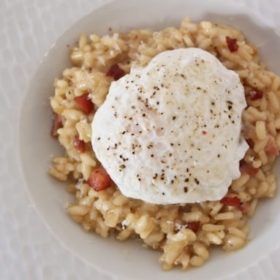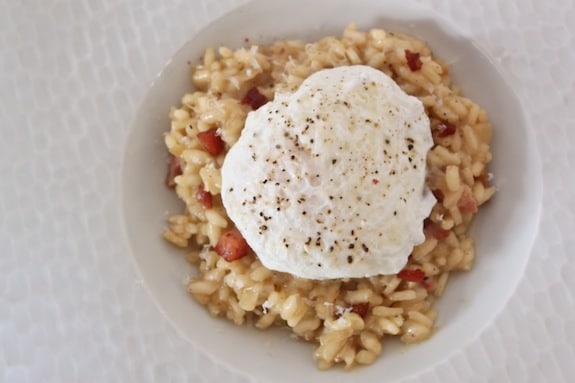– This easy risotto carbonara recipe is a work of art. –
Please welcome Casey Barber. Check out her clever rendition of carbonara, a classic pasta dish, below. For another fabulous risotto dish, check out my luscious lemon risotto recipe with fresh green peas.
Royal Tenenbaum decided he wanted to write his own epitaph, and so his tombstone displayed the masterpiece phrase “Died Tragically Rescuing His Family From The Wreckage Of A Destroyed Sinking Battleship.”
My tombstone, on the other hand, will probably list my recipe for spaghetti carbonara.
When there’s nothing else left in the fridge and I’ve reached desperation grocery store mode, I know there will still be eggs, garlic, copious amounts of Parmesan and black pepper, and a little pancetta stashed somewhere. I can make it for one person. I can make it for a crowd. Carbonara’s got all the food groups—well, let’s pretend you’re eating it with a green salad, ok?—and an appropriately fascinating history. Some speculate that the “carbonara” name refers to the Italian secret society of carbonari who might have brought the dish to Rome in the 1800s.
Others think it stems from the influence of American GIs who popularized the dish in World War II, combining their bacon and egg rations with Italian spaghetti. (In fact, carbonara makes an appearance on the restaurant Prune’s brunch menu and is referred to there as “Italian bacon and eggs.”) Still others think the name is a play on the specks of pepper that mimic the “carbon” flaking off coal miners who allegedly prepared the dish around campfires at the mine sites.
Whatever its murky backstory, carbonara has reached near-legend status in my house, and is the go-to quick-fix one-dish meal of choice for this Italian-American and her pasta-loving husband. But sometimes you don’t have spaghetti in the pantry. (Yes, this has happened. I’m ashamed.) And sometimes you feel like making a dish even more rib-sticking and filling than it needs to be. (Yes, I also keep my house at near-frigid levels in the winter. We need a lot of fuel to keep warm around here.) Ed Note: yes, it’s true, Casey’s house is, indeed, freezing.
And so I’ve turned my favorite pasta into my favorite risotto. The deeply browned pork fat on the bottom of the saucepan makes for a deep, almost beefy sauce, while the high-starch rice contributes crucial creaminess without adding a drop of heavy cream (Real carbonara does not contain cream, despite what you may have eaten in the past.) There’s one little concession that I make to differentiate the two. Rather than incorporating the egg into the sauce, as I do in the spaghetti version, I serve this dish topped with a poached egg and let the yolk ooze into the creamy rice with a quick slice of the fork.
Oh, and by-the-by: The key to always being ready to make carbonara is to freeze slices of pancetta between waxed paper so they’ll not only be pre-measured, but they’ll also be easier to cube instead of slipping greasily all over the cutting board.

Easy Risotto Carbonara Recipe
Ingredients
- 3 cups chicken broth
- 1/2 cup white wine
- 1 tablespoon kosher salt
- 1 tablespoon white vinegar
- 4 large eggs
- 1 teaspoon olive oil
- 1 cup cubed pancetta (1/4-1/2-inch cubes)
- 1 tablespoon unsalted butter
- 1 small yellow onion minced
- 1 large clove garlic minced
- 1 cup Arborio rice
- 1 teaspoon freshly ground black pepper
- 1/4 cup finely grated Parmesan cheese
Instructions
- Bring the chicken broth and wine to a simmer in a medium saucepan and keep warm over low heat.
- Prep an egg poaching station: fill a 2-quart stockpot with water and add the salt and vinegar. Crack one egg into a ramekin and have the other three eggs at the ready.
- Add the olive oil and pancetta to a large saucepan or deep skillet and cook, stirring occasionally, for about 10 minutes over medium-low heat until the pancetta renders its fat and browns to a crisp. You’ll develop a beautiful brown—not burnt! if it burns, turn the heat down!—crust on the bottom of the pan as the pancetta cooks.
- Remove the pancetta bits from the pan and reserve. Add the butter to the saucepan. When the butter is fully melted, add the onion and garlic and stir well to deglaze and scrape up all that gorgeous, tasty brown coating in the pan.
- Cook for about 5 minutes or until the onions are very soft and translucent. Stir in the rice and cook for 2-3 minutes to toast the kernels.
- Add 1/2 cup of the broth to the rice and stir gently until most of the liquid is absorbed. Continue to add broth 1/2 cup at a time, stirring gently as the rice continues to cook and absorb liquid.
- Halfway through adding the broth, bring the pot of salted, vinegared water to a bare simmer. Stir the simmering water with the end of a spoon or spatula to start a whirlpool effect in the pot, then gently pour the egg from the ramekin into the center of the whirlpool.
- Cook for 3-4 minutes to poach, then remove the egg with a slotted spoon onto a paper towel-lined plate. Repeat with the remaining three eggs while you continue to cook the risotto.
- After 15-20 minutes, most of the broth should be absorbed and the rice should taste tender and chewy but slightly firm to the bite. There will still be a good amount of sauce in the pan with the rice; risotto isn’t fluffy and dry like a pilaf, but retains a slightly soupy texture.
- Turn off the heat, stir in the pepper and Parmesan, and add salt to taste if needed. Spoon into four bowls and top each with a poached egg. Sprinkle with additional pepper and Parmesan to garnish.
Nutrition
This content was originally posted on FearlessFresh.com.

